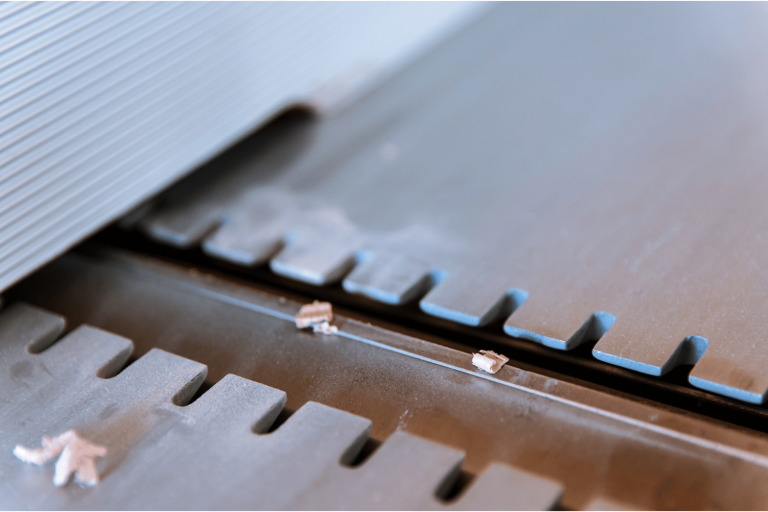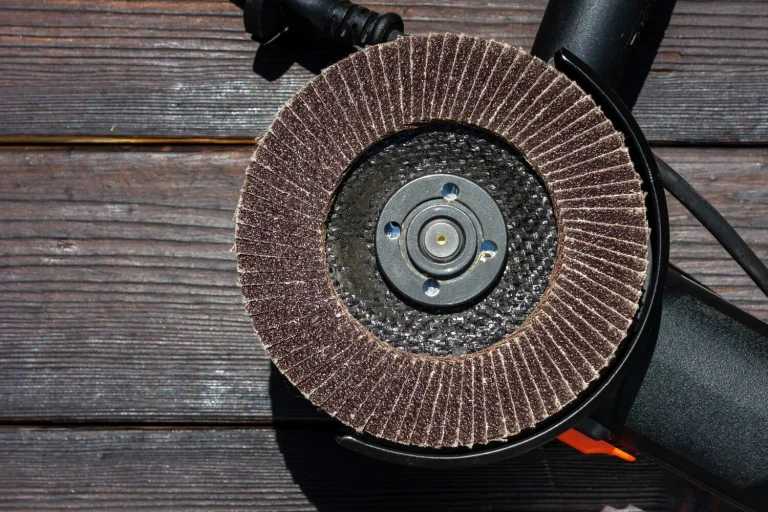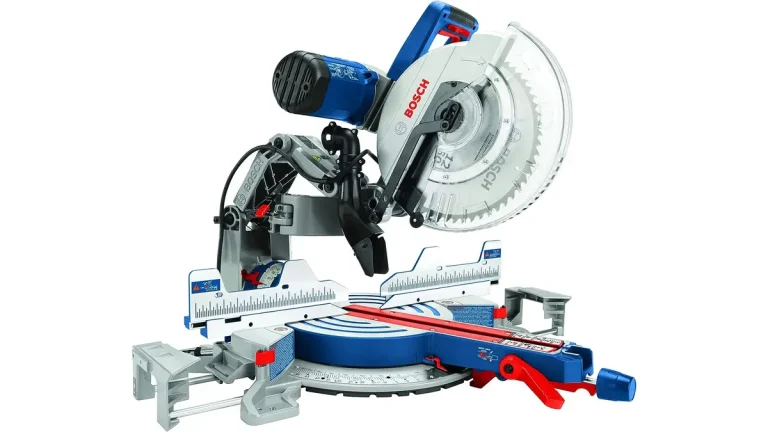What Is an Angle Grinder? The Buying Guide You Need
If you’re someone who desires control and enjoys getting hands-on with your projects, then you need to know about angle grinders. These powerful tools are a must-have for any DIY enthusiast or professional tradesperson.
With their ability to cut, grind, and polish a wide range of materials, angle grinders are incredibly versatile and indispensable in many industries.
An angle grinder is a handheld tool that uses a rotating disc to perform various tasks. From shaping metal to removing rust, an angle grinder can handle it all. But what sets it apart from other tools? Its compact size, lightweight design, and high-speed rotation make it ideal for intricate and precise work.
In this comprehensive guide, we will explore the different types of angle grinders available, their key features and components, and the various applications and uses. We will also delve into important safety considerations, provide tips and tricks for effective use, and discuss maintenance and care.
By the end, you’ll have all the knowledge you need to confidently wield an angle grinder and take control of your projects.
Key Takeaways
- Angle grinders are versatile and indispensable tools for DIY enthusiasts and professionals.
- There are two main types of angle grinders: electric-powered and pneumatic-powered.
- Key features to consider when choosing an angle grinder include motor power and speed, disc size, safety features, ergonomics, and handle options.
- Proper maintenance and care will ensure the longevity and performance of your angle grinder.
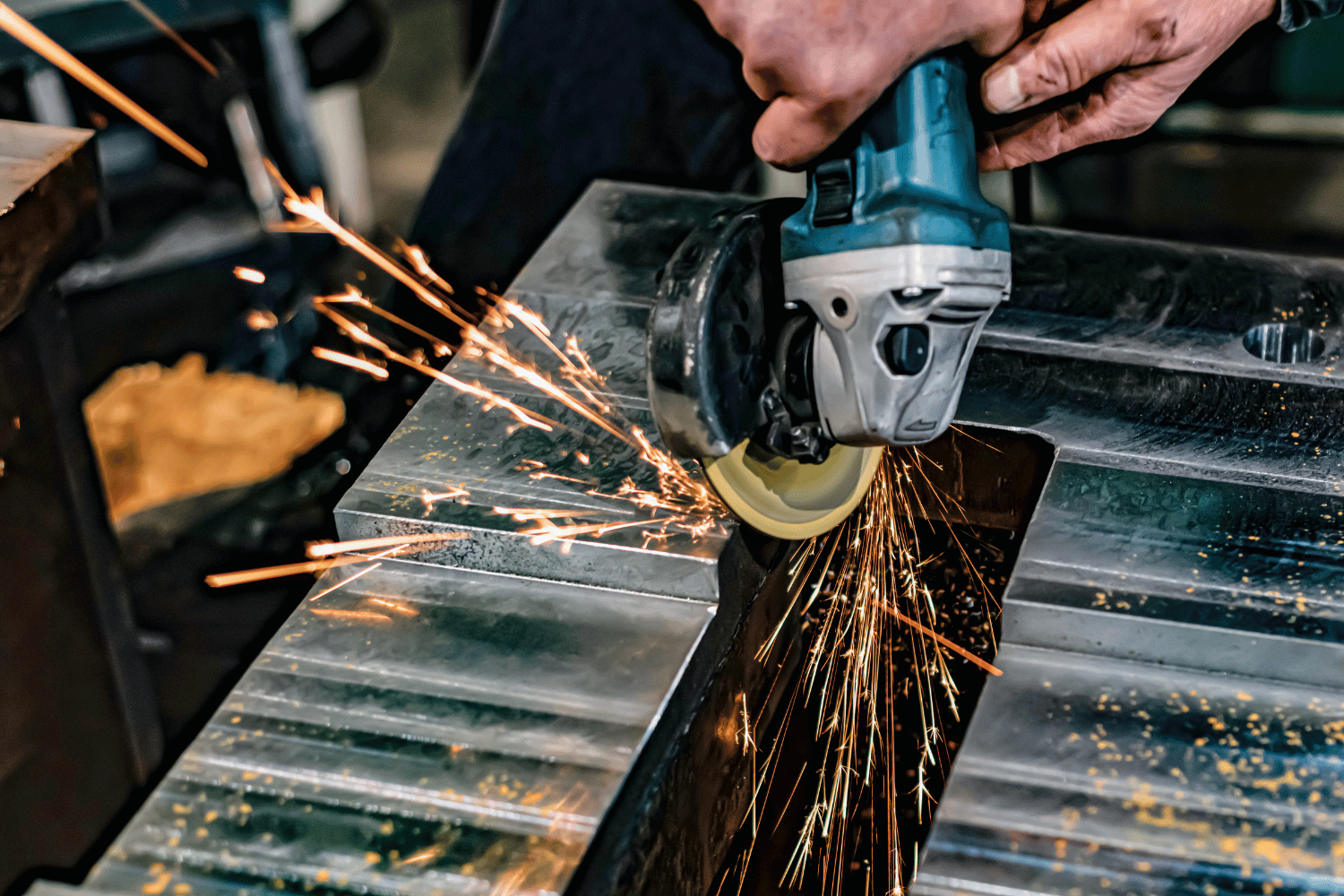
Types of Angle Grinders
When it comes to angle grinders, there are two main types to consider: electric-powered and pneumatic-powered.
Electric-powered angle grinders are the most common and widely used type. They have a motor that runs on electricity and provides consistent power. These grinders are generally more convenient and easier to use.
On the other hand, pneumatic-powered angle grinders are powered by compressed air. They are often preferred for heavy-duty applications due to their high power output. These grinders offer superior power and durability.
Comparing these two types, electric-powered angle grinders are generally more convenient and easier to use, while pneumatic-powered angle grinders offer superior power and durability.
Electric-powered angle grinders
To make your work easier and more efficient, opt for an electric-powered angle grinder. This tool allows you to effortlessly tackle any task at hand with its powerful motor and convenient corded or cordless design.
An angle grinder is a versatile tool that can be used for various applications such as cutting and grinding. It is equipped with different types of grinding discs, including cutting discs and wire brushes, to suit different tasks.
Electric-powered angle grinders offer several benefits. They have safety features such as a lock-on switch and adjustable side handle for better control. Some models also have variable speed settings, allowing you to adjust the grinder’s speed to match the task at hand.
Now, let’s move on to the next section about pneumatic-powered angle grinders.
Pneumatic-powered angle grinders
If you’re looking to explore another option for your grinding needs, consider trying out a pneumatic-powered angle grinder. This type of angle grinder is known for its impressive 80% faster grinding speed compared to its electric counterpart.
Pneumatic-powered angle grinders are commonly used for grinding tasks and are especially efficient when working with large angle grinder discs. The size of the disc used in pneumatic angle grinders can vary, with larger discs typically used for grinding and smaller discs used to cut.
These grinders are highly popular among professionals due to their power and precision. In the next section, we will compare different types of angle grinders and discuss their pros and cons, allowing you to make an informed decision.
Comparison of different types and their pros and cons
Now let’s take a look at the various types of angle grinders and their pros and cons, so you can make the best choice for your grinding needs.
- Corded Angle Grinder: The most common and versatile option is suitable for a wide range of applications and can accommodate various accessories like grinding discs, cutting blades, and flap discs.
- Cordless Angle Grinder: Offers the advantage of portability and freedom of movement, however, it may have limited power compared to corded models and requires regular battery charging.
- Pneumatic Angle Grinder: Provides high power and is commonly used in industrial settings. It requires an air compressor but offers excellent performance for heavy-duty tasks.
- Variable-Speed Angle Grinder: This allows you to adjust the rotational speed to match the specific material and application.
- Mini Angle Grinders: These are compact and lightweight, making them ideal for tight spaces and overhead work. However, they may have reduced power compared to larger models.
Remember to always wear proper personal protective equipment when using an angle grinder, such as safety glasses, gloves, and a dust mask.
Moving on to the next section about key features and components.
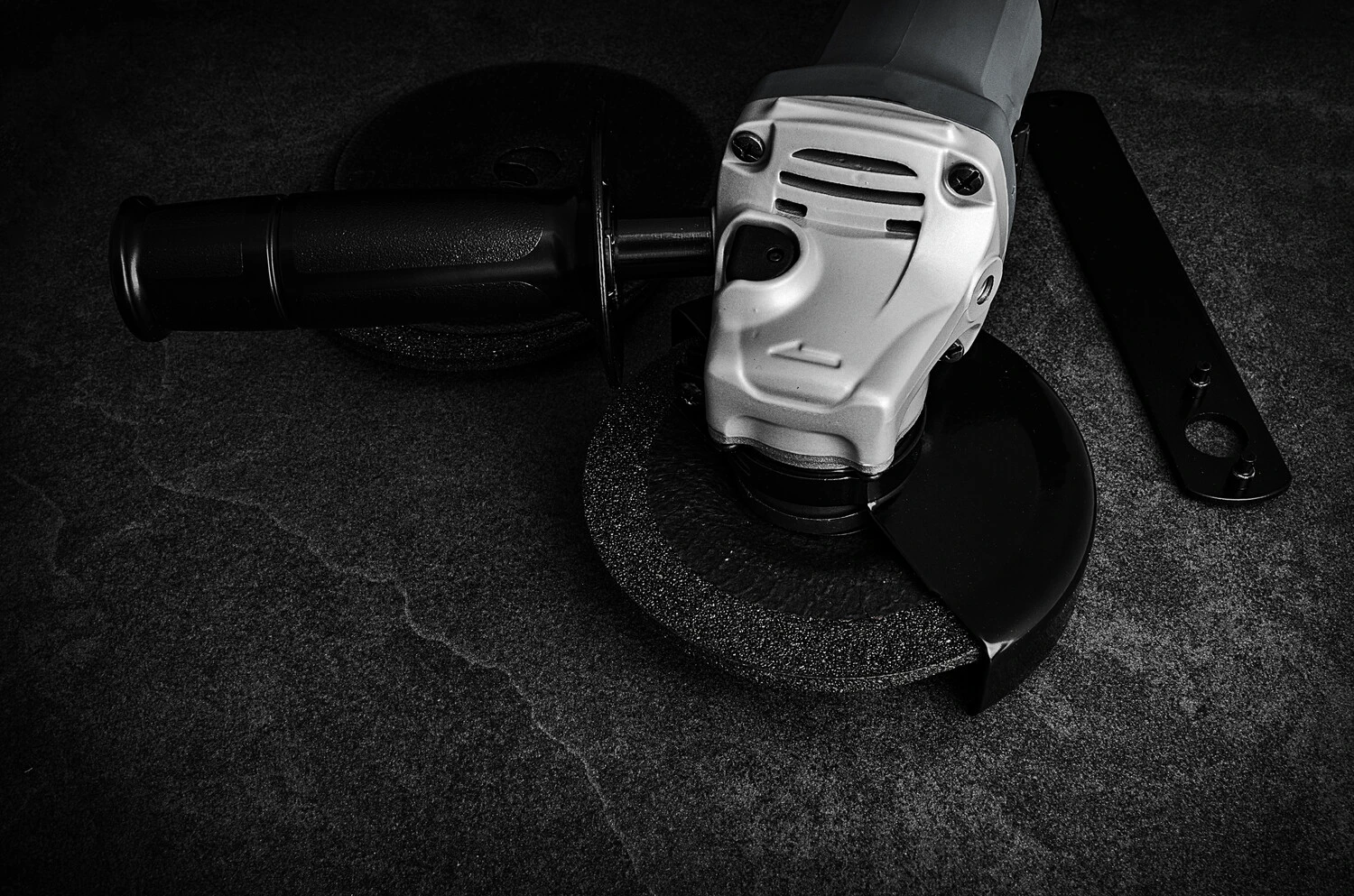
Key Features and Components
When considering an angle grinder, there are several key features and components to keep in mind. First, you’ll want to consider the motor power and speed, as this will determine the grinder’s performance.
Additionally, the disc size and types of discs available are important factors to consider, as they will dictate the grinder’s versatility and suitability for different tasks.
Safety features are also crucial, ensuring your protection while operating the grinder.
Ergonomics and handle options should not be overlooked, as these play a significant role in comfort and control during use.
Lastly, additional features such as adjustable side handles and tool-less disc change can greatly enhance the grinder’s functionality and ease of use.
Motor power and speed
With its powerful motor and lightning-fast speed, an angle grinder transforms even the toughest metal into fine dust in seconds.
Angle grinders work by using high-powered motors that generate high RPM (Rotations Per Minute), allowing the grinding or cutting of various materials.
Small angle grinders typically have motors ranging from 500 to 900 watts, while medium-sized angle grinders can have motors with power ratings between 900 and 1500 watts.
The high RPM and motor power of an angle grinder make it suitable for heavy-duty tasks, such as removing rust, cutting through metal pipes, or shaping stone.
Additionally, angle grinders often come with safety features like restart protection, which prevents accidental restarts after a power interruption.
Disc size and types of discs
Choose the right disc size and type to ensure efficient and effective grinding or cutting tasks. When selecting a disc for your angle grinder, consider the disc size and its compatibility with your tool.
Discs come in various sizes, ranging from 4 to 9 inches in diameter. Smaller discs are suitable for intricate tasks, while larger ones are ideal for heavy-duty applications.
Additionally, there are different types of discs available, each designed for specific materials and purposes. Grinding stones are perfect for metal and stone, while paint and rust removal discs are ideal for surface preparation. For polishing and sharpening, use polishing discs.
Remember to choose the appropriate disc size and type for your project to achieve the desired results.
Safety features
Ensure your safety by familiarizing yourself with the various safety features of your angle grinder. Angle grinders are powerful tools that can be dangerous if not used correctly.
When using an angle grinder, it’s essential to wear safety goggles to protect your eyes from sparks and debris. Additionally, always use the appropriate size and type of disc for the task at hand. Discs are used for various purposes, such as cutting, grinding, and polishing. To protect your hands, make sure to wear appropriate gloves that are suitable for the job.
Regularly inspect your angle grinder for any signs of wear and tear, and replace any damaged parts immediately. By following these safety precautions, you can ensure a safe and efficient operation of your angle grinder.
Ergonomics and handle options
Get a good grip on your angle grinder with the right handle option to make your grinding experience feel like holding a powerful lightning bolt in your hand. The ergonomics and handle options of an angle grinder play a crucial role in providing comfort and control while using this handheld power tool for a variety of jobs.
Whether you opt for an adjustable handle or a cordless model with a standard angle grinder handle, it’s important to choose one that suits your needs. The handle should fit comfortably in your hand, allowing you to maneuver the grinder with ease. Some handle options even offer additional features such as adjustable side handles and tool-less disc change, further enhancing your control over the tool.
With the right handle option, you can confidently tackle any task with precision and efficiency. Transitioning into the next section, let’s explore the additional features that can take your angle grinder to the next level.
Additional features
Equip your angle grinder with adjustable side handles and tool-less disc change for a power-packed experience that’ll revolutionize your grinding game. These additional features offer you enhanced control and convenience, allowing you to tackle even the toughest grinding tasks with ease.
Here are four key benefits of using adjustable side handles and tool-less disc change:
- Improved stability: The adjustable side handles provide a secure grip, reducing vibrations and improving overall stability during operation.
- Customizable positioning: With adjustable side handles, you can position them according to your preference and comfort, ensuring optimal control and reducing fatigue.
- Quick and easy disc changes: The tool-less disc change feature allows you to switch between different grinding discs effortlessly, saving you valuable time and effort.
- Enhanced safety: Adjustable side handles and tool-less disc change mechanisms contribute to a safer working environment, minimizing the risk of accidents and injuries.
By equipping your angle grinder with these features, you’ll be ready to explore the wide range of applications and uses that this versatile tool offers.
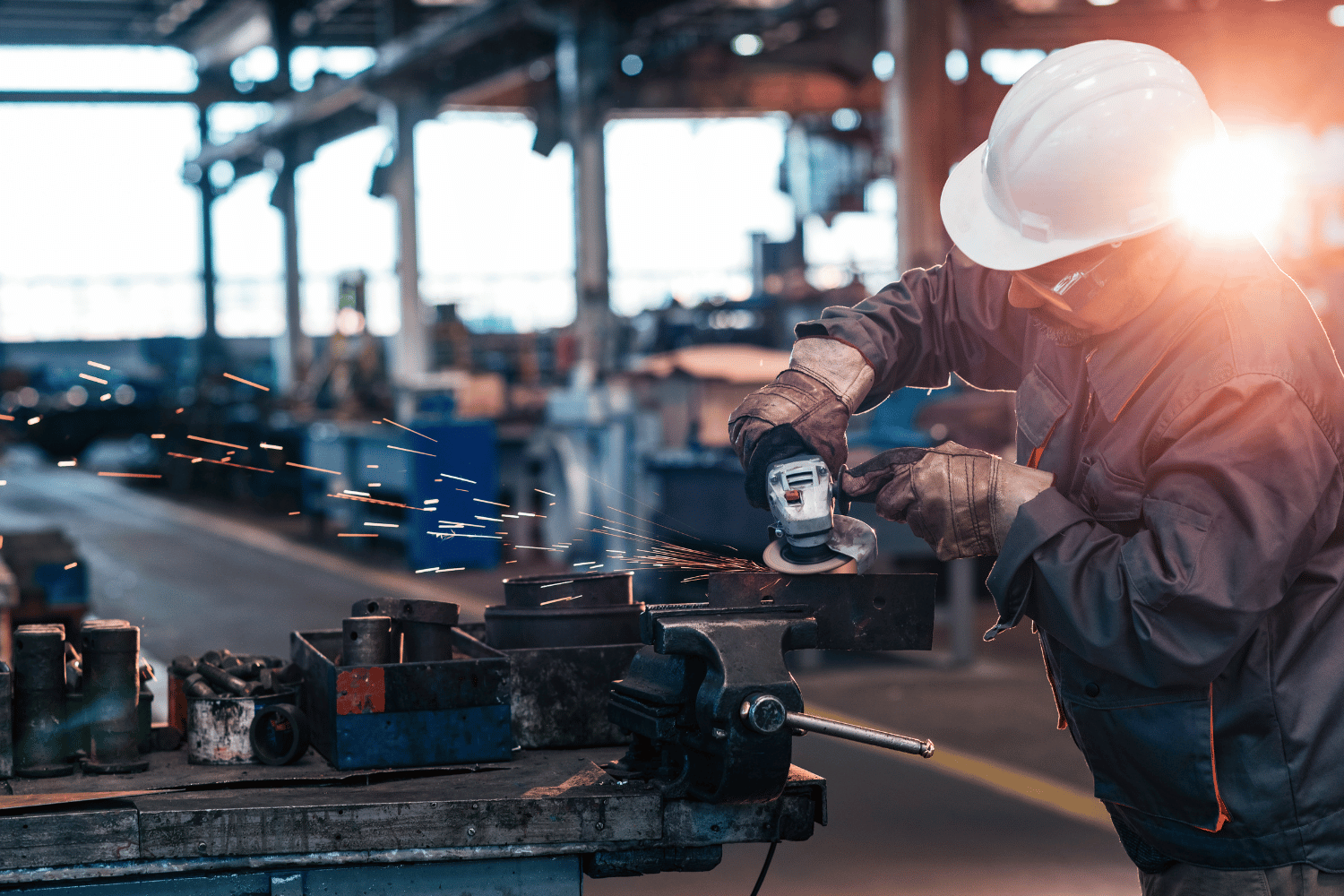
Applications and Uses
When it comes to metalworking and fabrication, an angle grinder is an essential tool that allows you to cut, grind, and polish various metal materials with precision.
In woodworking and carpentry, this versatile tool helps you shape and carve wood, making it a must-have for any woodworking project.
For masonry and concrete work, an angle grinder is perfect for cutting through tough materials, removing mortar, and smoothing surfaces.
Lastly, in automotive and restoration, this tool is indispensable for tasks such as cutting metal panels, grinding rust, and polishing surfaces to achieve a professional finish.
Metalworking and fabrication
Metalworking and fabrication involve using an angle grinder to effortlessly transform raw metal into intricate and polished designs. An angle grinder is a versatile tool that can grind materials and shape metal surfaces with precision.
It is commonly used in metalworking and fabrication to remove excess material, smooth rough edges, and create intricate patterns. The grinder’s powerful motor and abrasive disc make quick work of any metal, allowing you to cut out and shape complex designs with ease.
Whether you need to remove rust and paint or grind down welds, an angle grinder is the perfect tool for the job.
In the next section about woodworking and carpentry, we will explore how an angle grinder can be similarly useful in these applications.
Woodworking and carpentry
To achieve precise cuts and smooth finishes in woodworking and carpentry, you’ll find it fascinating that professionals use a versatile power tool called an angle grinder. This tool is capable of shaping and polishing wood surfaces effortlessly, making it an essential tool in any woodworker’s arsenal.
An angle grinder can be used to quickly remove excess material, such as when cutting a piece of wood to size or shaping it into a specific form. The angle grinder typically features a spinning disc with abrasive particles that can easily grind away wood fibers. Additionally, grinders also come with various attachments, such as sanding discs, which can be used to smooth and polish wood surfaces to a fine finish.
Using the angle grinder in woodworking and carpentry provides control and precision, ensuring your projects turn out exactly as intended. Moving on to the next section, let’s explore how angle grinders are used in masonry and concrete work.
Masonry and concrete work
For those involved in masonry and concrete work, honing your skills with an angle grinder will open up a world of possibilities. It will help you achieve precise cuts and flawless finishes. Angle grinders are versatile power tools primarily used for making cuts and shaping materials such as bricks and blocks.
When choosing an angle grinder, there are various options available. One option is the die grinder, which is smaller and more compact. Before using the angle grinder, you must ensure that the spindle lock is engaged. This will keep the grinding wheel securely in place.
Angle grinders can also be used for grinding and polishing concrete surfaces. This can help achieve a smooth finish. However, you need to be cautious as the powerful spinning disc can get in the way. Therefore, proper control and safety precautions are essential.
Moving on to the next topic of automotive and restoration, angle grinders continue to play a crucial role in various applications.
Automotive and restoration
Rev up your skills and unlock a world of automotive possibilities with the versatile power of an angle grinder. This essential tool is a game-changer for automotive and restoration work.
With its ability to remove welds and excess materials, an angle grinder is perfect for smoothing, shaping, and restoring metal surfaces. Its compact size and powerful brushless motor make it easy to maneuver in tight spaces.
Depending on the task at hand, you can choose from a variety of wheel attachments, such as grinding wheels, cutting wheels, or wire brushes. An angle grinder can also be used with an air compressor for added power.
When working on automotive projects, it’s important to make precise and controlled movements to achieve the desired results. Safety considerations are crucial in order to protect yourself and others from potential hazards.

Safety Considerations
When using an angle grinder, it’s crucial to prioritize your safety by wearing personal protective equipment (PPE) such as safety glasses, gloves, and earplugs.
Additionally, make sure you use proper handling and grip techniques to maintain control of the tool and prevent accidents.
Creating a safe work environment involves removing any potential hazards, securing the workpiece, and keeping bystanders at a safe distance.
It’s important to select the appropriate disc for your task and follow usage guidelines provided by the manufacturer.
Lastly, regular maintenance and inspection of the angle grinder will help identify any potential issues and ensure its safe and efficient operation.
Personal protective equipment (PPE)
Make sure you’re wearing the proper PPE, like safety goggles and gloves, before using an angle grinder. Safety goggles are essential to protect your eyes from flying debris and sparks.
Gloves, on the other hand, provide a barrier between your skin and the grinder’s abrasive wheel, reducing the risk of cuts and burns. When selecting goggles, opt for ones with side shields for maximum protection. Additionally, choose gloves that fit snugly and are made of a durable material, like leather or Kevlar.
Remember, PPE alone isn’t enough; it must be worn correctly. Ensure the goggles fit securely and the gloves cover your hands fully. Proper PPE is the first line of defense, but it’s equally important to learn proper handling and grip techniques to maintain control and minimize accidents.
Proper handling and grip techniques
To ensure your safety while using an angle grinder, it’s crucial to master proper handling and grip techniques. By maintaining a firm hold on the tool and using both hands to control its movement, you decrease the likelihood of accidents and increase your control over the powerful tool.
When gripping the grinder, make sure your dominant hand is firmly grasping the main handle, while your other hand supports the grinder’s body near the auxiliary handle. This allows for a balanced and stable grip, giving you the confidence to maneuver the grinder with precision.
Additionally, it’s essential to keep your wrists straight and avoid excessive bending or twisting motions. By following these handling and grip techniques, you’ll have the necessary control to safely operate the angle grinder.
Safe work environment and precautions
Creating a safe work environment and taking necessary precautions involves setting up a clean and organized workspace, using proper personal protective equipment (PPE), and being aware of your surroundings at all times.
Start by ensuring that your workspace is clean and free of any debris or clutter that could potentially cause accidents. Organize your tools and materials in a way that allows for easy access and minimizes the risk of tripping or falling.
Additionally, always wear the appropriate PPE, including safety goggles, gloves, and ear protection, to protect yourself from flying debris, sparks, and loud noise.
Finally, be constantly aware of your surroundings, paying attention to potential hazards such as electrical cords, flammable materials, or other people in the vicinity.
By following these precautions, you can create a safe and controlled work environment.
Disc selection and usage guidelines
When selecting and using different types of discs, it’s crucial to consider the specific material you’ll be working with and the desired outcome, as this will determine the appropriate disc for the job.
Here are five important factors to consider when selecting and using discs for your angle grinder:
- Disc Type: There are various types of discs available, such as grinding, cutting, and sanding discs. Each type serves a specific purpose, so choose accordingly.
- Disc Size: The size of the disc should match the size of your angle grinder. Using an incompatible size can lead to accidents and damage.
- Disc Material: Different discs are designed for specific materials like metal, concrete, or wood. Make sure to select the appropriate disc for the material you’re working on.
- Disc Speed: Pay attention to the maximum speed rating of the disc and ensure it matches the specifications of your angle grinder.
- Disc Safety: Always check for any cracks, chips, or damage before using a disc. Damaged discs should be discarded immediately to prevent accidents.
Considering these factors will help you select the right disc for your angle grinder and ensure a safe and efficient operation.
Maintenance and inspection of the angle grinder
Now that you understand the importance of disc selection and usage guidelines, let’s move on to the maintenance and inspection of your angle grinder.
Proper maintenance is crucial to ensure the longevity and performance of your tool. Start by regularly inspecting the power cord for any signs of damage, such as fraying or exposed wires.
Check the disc guard to make sure it’s securely in place and functioning properly. Additionally, inspect the disc itself for any cracks, chips, or excessive wear.
Clean your angle grinder after each use, removing any debris or buildup that may affect its performance. Remember to lubricate the moving parts and tighten any loose screws or bolts.
By taking these maintenance steps, you can ensure that your angle grinder remains safe and efficient.

Tips and Tricks for Effective Angle Grinder Use
When using an angle grinder, it’s crucial to choose the right disc for the task at hand. This ensures that you achieve the desired results and prevent any potential accidents.
Additionally, proper positioning and technique for cutting and grinding are essential for a safe and effective operation. By maximizing efficiency and reducing material wastage, you can save both time and money.
Lastly, handling common challenges and troubleshooting issues that may arise during angle grinder use will help you overcome any obstacles and ensure a smooth workflow.
Choosing the right disc for the task
To make sure you have the best results, it’s crucial to select the right disc for the task at hand when using an angle grinder. Here are four types of discs commonly used and their corresponding uses:
- Cutting discs: These discs are designed for cutting through materials like metal, concrete, and tiles. They have a thin profile and sharp edges to provide clean and precise cuts.
- Grinding discs: Used for grinding and smoothing surfaces, these discs are thicker and have abrasive grains embedded in them. They are ideal for removing rust, paint, and weld splatter.
- Flap discs: These discs are versatile and can be used for both grinding and finishing applications. They have overlapping flaps of abrasive material that provide a consistent finish and longer lifespan.
- Wire brush discs: Designed for removing rust, paint, and corrosion, wire brush discs have bristles made of wire that effectively clean and prepare surfaces.
Choosing the right disc for your task will ensure optimal performance and safety. Now, let’s move on to the proper positioning and technique for cutting and grinding.
Proper positioning and technique for cutting and grinding
Once you’ve chosen the right disc for your task, it’s time to position yourself and master the technique for cutting and grinding with precision and finesse.
To ensure optimal control, firmly grip the angle grinder with both hands and position your body in a stable stance. Maintain a comfortable distance from the workpiece, allowing the disc to make contact at the correct angle. Keep a steady hand while applying gentle pressure to the grinder, allowing the disc to do the cutting or grinding work.
It’s crucial to move the grinder in a smooth, controlled motion, avoiding any jerky movements that may cause errors or accidents. Remember to wear appropriate safety gear, such as goggles and gloves, to protect yourself from debris and sparks.
By mastering these techniques, you can maximize efficiency and reduce material wastage in your cutting and grinding tasks.
Maximizing efficiency and reducing material wastage
By firmly gripping the angle grinder with both hands and positioning your body in a stable stance, you can effectively maximize efficiency and reduce material wastage during cutting and grinding tasks. Secure your dominant hand on the main handle and place your other hand on the auxiliary handle for better control and balance.
Maintain a firm grip throughout the task to prevent any accidents or slippage. When cutting or grinding, apply steady and even pressure to the workpiece, avoiding excessive force that could lead to overheating or premature wear of the grinder.
Additionally, make sure to adjust the speed and angle of the grinder based on the material being worked on, as this can greatly impact the efficiency and quality of the task. By following these techniques, you can minimize material wastage and achieve precise results.
Handling common challenges and troubleshooting issues
When faced with obstacles and unexpected problems while using an angle grinder, it’s like navigating a treacherous path in the dark, requiring quick thinking and adaptability to overcome them.
One common challenge is disc jamming, which can occur when the material being worked on gets wedged between the disc and the guard. To prevent this, always maintain a steady grip on the grinder and avoid excessive force.
Another issue that may arise is overheating, which can lead to motor damage. To combat this, make sure to use the grinder in short bursts and allow it to cool down between uses.
Additionally, if you experience excessive vibration, it could indicate a problem with the disc or the machine itself. In such cases, inspect the disc for damage or replace it if necessary.
Maintenance and Care
When it comes to maintaining and caring for your angle grinder, there are a few key points to keep in mind. Firstly, make sure to regularly clean and remove any debris from the tool, as this can affect its performance.
Secondly, lubricate and inspect the moving parts to ensure smooth operation and prevent any potential damage.
Lastly, be sure to replace any worn-out discs and components to maintain optimum functionality.
Additionally, consider storage and transportation considerations to protect the tool from any potential damage.
Cleaning and removing debris
The angle grinder effortlessly sweeps away dirt and dust, leaving behind a clean and pristine surface. To effectively clean and remove debris from your angle grinder, there are a few steps you should follow.
First, ensure that the grinder is turned off and unplugged. Use a brush or compressed air to remove loose dust and debris from the exterior of the tool.
Next, remove the wheel guard and brush away any dirt or debris that may have accumulated. Take care to clean the spindle and arbor nut as well.
Finally, inspect the entire tool for any remaining debris and clean as necessary. Once the cleaning process is complete, it’s important to move on to the next step, which involves lubrication and inspection of moving parts, ensuring optimal performance and longevity of your angle grinder.
Lubrication and inspection of moving parts
Now that you’ve successfully cleaned and removed debris from your angle grinder, it’s time to move on to the next critical step in maintaining its optimal performance – lubrication and inspection of moving parts.
Regular lubrication is essential for ensuring smooth operation and preventing excessive wear and tear on the components. Start by applying a small amount of high-quality lubricating oil to the gears, bearings, and other moving parts. Be sure to check for any signs of damage or excessive wear while you’re at it.
Inspecting the brushes, armature, and other crucial components will help you catch any potential issues early on and avoid costly repairs.
Replacing worn-out discs and components
To ensure optimal performance, it’s important to replace worn-out discs and components in your angle grinder. Over time, the discs can become dull or damaged, resulting in decreased efficiency and potential safety hazards.
Begin by disconnecting the power source and removing the disc guard. Carefully examine the disc for signs of wear, such as cracks or missing segments. If any damage is found, replace the disc with a new one that matches the specifications of your grinder.
Additionally, inspect other components, such as the spindle lock and the flange, for any signs of wear or damage. Replace these parts if necessary to maintain smooth operation.
By regularly replacing worn-out discs and components, you can ensure that your angle grinder operates at its best.
Storage and transportation considerations
When it comes to storing and transporting your angle grinder, you’ll want to ensure its safety and protect it from any potential damage. To start, make sure the grinder is turned off and unplugged before storing or moving it. Store it in a secure and dry place, away from any corrosive substances or extreme temperatures.
Keep the grinder in its original case or use a sturdy toolbox to prevent it from getting bumped or scratched. Additionally, consider using a lock or a safety strap to secure it during transportation.
When transporting the angle grinder, be cautious of sharp edges and rotating parts. Always use the appropriate safety gear, such as gloves and goggles, and securely fasten the grinder to prevent it from shifting or falling.
Following these storage and transportation considerations will help prolong the lifespan of your angle grinder and ensure safe usage.
Frequently Asked Questions
How do I choose the right disc for my angle grinder?
To choose the right disc for your angle grinder, consider the material you’re working with and the task at hand. For cutting, use abrasive discs; for grinding, opt for grinding discs. Always prioritize safety and wear appropriate protective gear.
Can an angle grinder be used for cutting concrete?
Yes, an angle grinder can be used for cutting concrete. To do so, you need a diamond blade specifically designed for cutting concrete. Ensure proper safety precautions and follow the manufacturer’s instructions for best results.
What precautions should I take when using an angle grinder for the first time?
Before using an angle grinder for the first time, ensure your safety by wearing protective gear such as goggles, gloves, and a dust mask. Secure the workpiece and practice proper technique to avoid accidents.
Can an angle grinder be used to sharpen tools?
Yes, an angle grinder can be used to sharpen tools. It is equipped with a grinding wheel that can remove material from the tool’s edge, restoring its sharpness. Proper technique and safety precautions must be followed.
Are there any alternative tools that can be used instead of an angle grinder for specific tasks?
Yes, there are alternative tools that can be used instead of an angle grinder for specific tasks. However, none of them offer the same power, versatility, and efficiency that an angle grinder provides.
Final Thoughts
So there you have it. You’re now a bonafide expert on angle grinders. From the different types to the key features and components, you’ve soaked up all the knowledge like a sponge.
And let’s not forget the applications and uses, because who doesn’t love a versatile tool? But remember, safety first, my friend. Don’t go grinding away without considering the precautions.
And lastly, keep your angle grinder in tip-top shape with some good ol’ maintenance and care. Now go forth and grind like a pro!



